2020-2021 Indiana Fishing Regulation Guide is out
Pick up your hard copy of the 2020-2021 Indiana Fishing Regulation Guide this month from one of our properties or retailers.
The guide is now available online.
Highlights of the new guide include: 2020 free fishing days, 2019 Fish of the Year winners, State Record Fish, crappie fishing locations and tips, and information about Indiana’s striped bass management program. |
|
 |
Visit DNR at the Boat, Sport & Travel Show
Buy your licenses, state park passes, boat permits, and more at the Indianapolis Boat, Sport and Travel Show, Feb. 14-23, at the Indiana State Fairgrounds. DNR will be located at Tackle Town in the Blue Ribbon Pavilion. The show is presented by Renfro Productions and opens at 1 p.m. on Friday, Feb. 14.
Enter your trophy fish into Fish of the Year
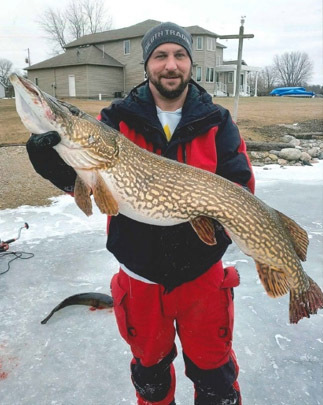
Indiana DNR’s Fish of the Year Program awards anglers who have submitted the largest fish from Hoosier waters of each species. Winners receive a certificate, patch, and bragging rights for the entire year.
If your fish is a potential state record, follow the instructions on our website to submit a state record. Current state record fish, Fish of the Year winners, and instructions for submitting Fish of the Year entries are also available.
Pictured right: Adam Smith, 2019 Fish of the Year winner for Northern pike.
|
Mark your calendar for 2020 Free Fishing Days
This year's four free fishing days are May 3, June 6-7, and Sept. 26. Indiana residents do not need a fishing license or a trout stamp to fish in public waters on these days.
 Join us for Marsh Madness, Feb. 28-29
The annual Marsh Madness Sandhill Crane Festival will be Feb. 28-29, starting at 5 p.m. on Feb. 28 with a kickoff banquet. This community-based bird festival celebrates the annual spring migration of sandhill cranes and waterfowl to Goose Pond Fish & Wildlife Area.
The festival will feature a craft fair, live birds of prey, kids activities, and much more. This event is led by the Friends of Goose Pond through a partnership with the Indiana Division of Fish & Wildlife.
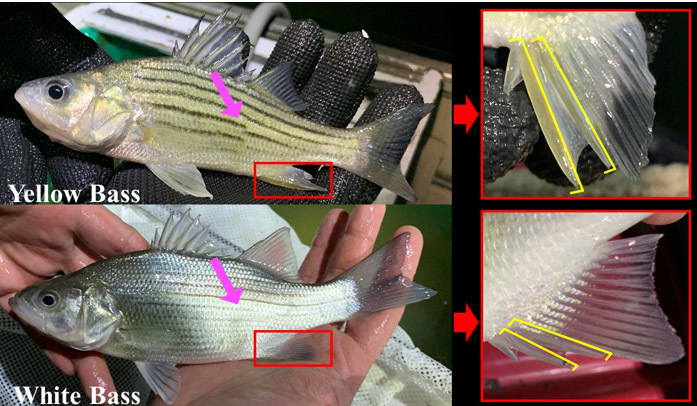 Differences in striping and anal spine length between yellow and white bass.
Identifying true bass in Indiana
Yellow, white, striped, and hybrid striped bass are members of the true bass family (Moronidae) and can be found throughout Indiana. Yellow and white bass are both native to the state and often coexist. White bass were stocked in many of our reservoirs during the 1970s and 1980s to create more fishing opportunities.
Today, their populations are maintained by natural reproduction. Striped and hybrid striped bass do not reproduce naturally in Indiana. Therefore, their populations are maintained only through stockings. Striped and hybrid striped bass grow much larger than yellow and white bass.
Yellow bass have never been stocked by the DNR. In fact, yellow bass can be problematic when introduced into water bodies with high nutrient levels because of population increases that can negatively affect other sport fish. White bass and yellow bass are often confused by anglers. Yellow bass are yellow in color with more distinctive striping and a second anal spine that is equal in length to the third (see above). By comparison, white bass have fainter stripes, a deeper body, and their second anal spine is ¾ the length of the third.
 |
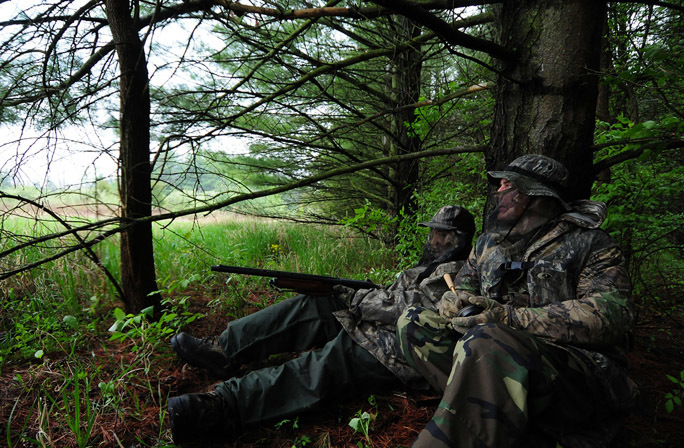 Deadline for reserved turkey hunts approaching
Remember to apply for reserved turkey hunts on public and private land before Feb. 19. The online method is the only way to apply.
2020-21 hunting seasons dates available
The 2020-2021 hunting seasons are now posted. Dates for migratory bird and waterfowl seasons will become available in the summer. Those seasons are set by the U.S. Fish and Wildlife Service in cooperation with the DNR Division of Fish & Wildlife.
Your 2019 hunting and fishing licenses are valid through March 31, 2020.
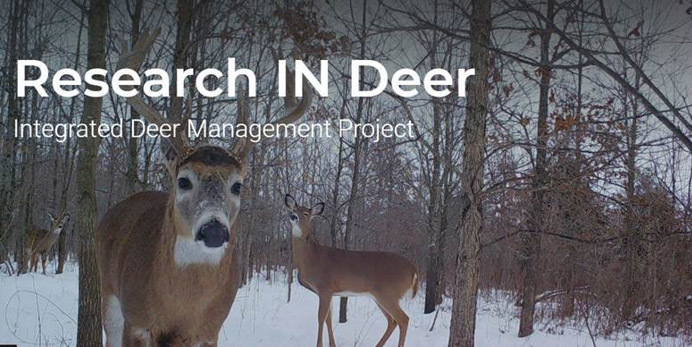 DNR and Purdue partner on deer project
Indiana DNR is excited to partner with Purdue Forestry and Natural Resources on the Integrated Deer Management Project. The project will combine deer population and habitat condition information with public perceptions of deer and deer management to better inform white-tailed deer management in Indiana.
To accomplish this, the project will undertake a series of research studies split into three broad categories: deer, habitat, and people. You can stay tuned to updates by following @researchINdeer on Twitter.
Learn more about white-tailed deer at deer.dnr.IN.gov.
 Photo courtesy of the U.S. Fish and Wildlife Service
Living with Wildlife: Canada Geese
Canada geese begin scouting for nesting areas in February and this is when goose management techniques should begin. Canada geese prefer to nest near water bodies that are surrounded by short, mowed grass and have a clear line of sight to look for potential predators.
Fortunately, implementing harassment techniques, installing fencing or other barriers, and the avoidance of feeding geese can prevent unwanted nesting on your property. For more information on these practices and how to do them, visit our website.
A permit is not required to harass geese if they are not physically harmed. If necessary, nests without eggs or birds can be removed at any time without a permit.
Invitation to comment on proposed rule changes
The Natural Resources Commission (NRC) gave preliminary adoption to a number of Fisheries, Wildlife, and Permit-related rule proposals on Jan. 21. Proposed changes include allowing air bows and air rifles that meet certain specifications during the deer firearms season and adding ruffed grouse, cisco, and western sand darter to the list of endangered species. For a complete list with rationales, visit our website.
Public hearings have not been scheduled yet, but comments can now be submitted online. Scroll down to the rule making docket and click on “comment on this rule” next to the FW Biennial Fisheries Amendments or the FW Biennial Wildlife Amendments, whichever is applicable for your comment. Comments can also be mailed to: Natural Resources Commission; Indiana Government Center North; 100 North Senate Ave., Room N501-A; Indianapolis, IN 46204.
The NRC will review the public comments before voting on final adoption of the changes later in 2020. Rule changes that are given final adoption must still be approved by the Attorney General’s Office and Governor’s Office and filed with the Indiana Register before taking effect.
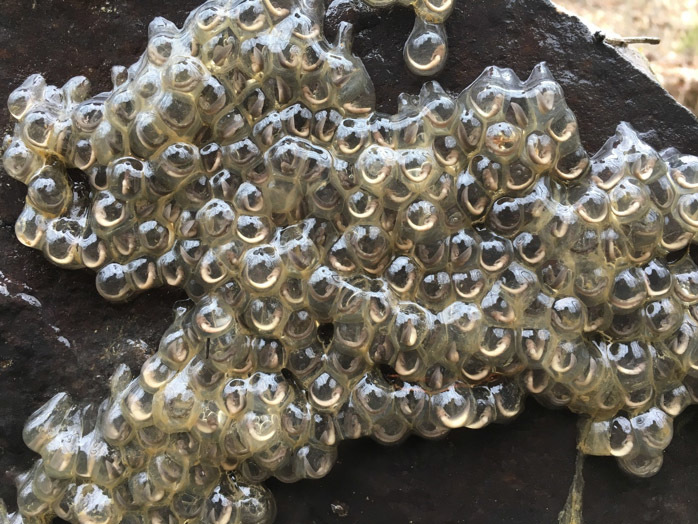 Streamside salamander eggs found by Indiana DNR herpetologists
Nongame Wildlife Fund at Work: Amphibians
Indiana’s salamanders occupy a diverse array of habitats and despite their secretive nature, can be found any month of the year under the right conditions. For DNR herpetologists, salamanders serve as “bookends” to the field season, often starting with the early season surveys for streamside salamanders (Ambystoma barbouri), a species of special concern, and concluding with surveys for state endangered green salamanders (Aneides aeneus). Surveys for these two species require different techniques that both involve searching around rock.
Streamside salamanders live underground, but migrate to streams to deposit their eggs on the underside of submerged rocks and other material (pictured above). Green salamanders are typically found hiding within rock outcrops, tucked into the cracks and fissures they use as shelter. Both species were found at several new locations during 2019 surveys.
Monitoring efforts are supported by Indiana’s Nongame Wildlife Fund. Consider donating to help rare salamander species continue to persist in Indiana.
 |
Upcoming events
Feb. 22 – Flying WILD Educator Workshop, Bloomington
Feb. 29 – Wood Duck Box Placement Day, J. E. Roush Lake Fish & Wildlife Area
Feb. 29 – Project WILD Educator Workshop, Gary
March 7 – Turkey Hunting 101, Kingsbury Fish & Wildlife Area
Recent news releases
Applications for CHAP available through March 31
Regulations for catching some Ohio River fish change
Pigeon River FWA manager receives award
Reserved turkey hunt applications for private lands now being accepted
Help our wildlife by donating on your state taxes
More

About Fish and Wildlife Management in Indiana
Fish and wildlife management and public access are funded by fishing and hunting license revenue and also through the Wildlife and Sport Fish Restoration Programs administered by the U.S. Fish & Wildlife Service. These programs collect excise taxes on sporting arms and ammunition, archery equipment, fishing equipment, and motor boat fuels. The money is distributed among state fish and wildlife agencies based on land size and the number of licensed anglers and hunters in each state. Find out more information about fish and wildlife management in Indiana at Wildlife.IN.gov.
|